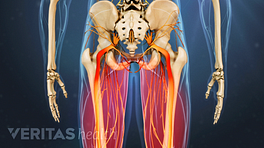As the facet joints in the spine degenerate they often get larger, which can encroach upon the spinal canal that runs down the middle of the spinal column, resulting in spinal stenosis. The symptoms of a degenerative spondylolisthesis are very commonly the same as that of spinal stenosis.
The main symptoms of degenerative spondylolisthesis include:
- Lower back pain and/or leg pain are the most typical symptoms of degenerative spondylolisthesis. Some patients do not have any back pain with degenerative spondylolisthesis and others have primarily back pain and no leg pain.
Degenerative spondylolisthesis is a spinal condition in which one vertebra slips forward in front of the vertebra beneath it.
- Patients often complain of sciatic pain, an aching in one or both legs, or a tired feeling down the legs when they stand for a prolonged period of time or try to walk any distance (called pseudoclaudication).
- Generally, patients do not have a lot of pain while sitting, because in the sitting position the spinal canal is more open. In the upright position, the spinal canal gets smaller, accentuating the stenosis and pinching the nerve roots in the canal.
- Patients typically have tight hamstring muscles (the muscles in the back of the thigh) decreased flexibility in the lower back, and difficulty or pain with extension (arching the back backwards).
- The nerve root pinching can lead to weakness in the legs, but true nerve root damage is rare.
There is no spinal cord in the lumbar spine, so even for patients with severe pain, there is no danger of spinal cord damage. If the spinal stenosis becomes very severe, or if the patient also has a disc herniation, they can develop cauda equina syndrome where there is progressive nerve root damage and loss of bladder/bowel control. This clinical syndrome is very rare, but if it does occur it is a medical emergency.








